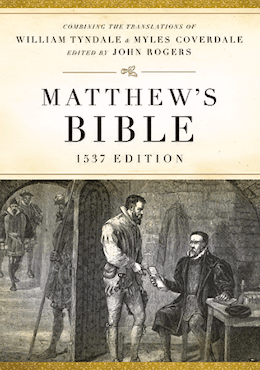Textus Receptus Bibles
Matthew's Bible 1537
| 5:1 | Whosoeuer beleueth that Iesus is Christ, is borne of God. And euerye one that loueth hym whiche begat, loueth hym also whyche was begotten of hym. |
| 5:2 | In thys we know, that we loue the children of God, when we loue God and kepe his commaundementes. |
| 5:3 | This is the loue of God, that we kepe his commaundementes, and his commaundementes are not greuous. |
| 5:4 | For all that is borne of God, ouercommeth the world. And this is the victorye, that ouercommeth the worlde, euen oure fayeth. |
| 5:5 | Who is it that ouercommeth the worlde, but he which beleueth, that Iesus is the sonne of God? |
| 5:6 | This Iesus Christ is he that came by water and bloude, not by water onelye, but by water and bloud. And it is the spirite that beareth witnes, because the spirite is trueth. |
| 5:7 | (For there are thre which beare recorde in heauen, the father, the worde, and the holye Ghoste. And these thre are one.) |
| 5:8 | For there are thre, whiche beare recorde in earth the spyrite and water, and bloude, and these thre are one. |
| 5:9 | If we receyue the wytnes of men, the wytnes of God is greater. For thys is the wytnes of God, whiche he testified of his sonne. |
| 5:10 | He that beleueth on the sonne of God, hath the wytnes in him selfe. He that beleued not God, hath made hym a lyar, because he beleued not the recorde, that God gaue of hys sonne. |
| 5:11 | And thys is that recorde, howe that God hath geuen vnto vs eternal lyfe, and this lyfe is in his sonne. |
| 5:12 | He that hath the sonne, hath lyfe: and he that hath not the sonne of God, hath not lyfe. |
| 5:13 | These thinges haue I wryten vnto you, that beleue on the name of the sonne of God, that ye maye know, how that ye haue eternal lyfe, and that ye may beleue on the name of the sonne of God. |
| 5:14 | And this is the truste that we haue in him, that yf we axe any thinge, accordinge to hys will he heareth vs. |
| 5:15 | And yf we knowe that he heareth vs whatsoeuer we axe, we knowe, that we shall haue the peticyons that we desyre of hym. |
| 5:16 | If any man se his brother synne a synne that is not vnto death, let him axe, and he shal geue him lyfe, for them that synne not vnto death. There is a synne vnto death, for which saye I not that a man shoulde praye. |
| 5:17 | All vnryghtuousnes is synne, and there is sinne not vnto death. |
| 5:18 | We knowe that whosoeuer is borne of God, synneth not, but he that is begotten of God kepeth him selfe, and that wycked toucheth him not. |
| 5:19 | We knowe that we are of God, and that the world is altogether set on wyckednes. |
| 5:20 | We know, that the sonne of God is come, & hath geuen vs a minde to know him which is true, & we are in him, that is true thorowe his sonne Iesus Christ. This same is verye God, and eternal lyfe. |
| 5:21 | Babes kepe your selues from Images. Amen. |

Matthew's Bible 1537
The Matthew Bible, also known as Matthew's Version, was first published in 1537 by John Rogers, under the pseudonym "Thomas Matthew". It combined the New Testament of William Tyndale, and as much of the Old Testament as he had been able to translate before being captured and put to death, with the translations of Myles Coverdale as to the balance of the Old Testament and the Apocrypha, except the Apocryphal Prayer of Manasses. It is thus a vital link in the main sequence of English Bible translations.